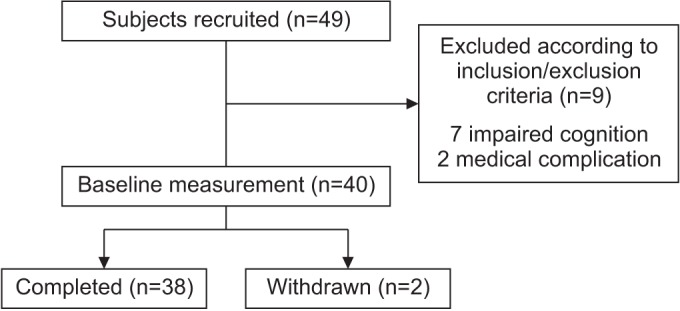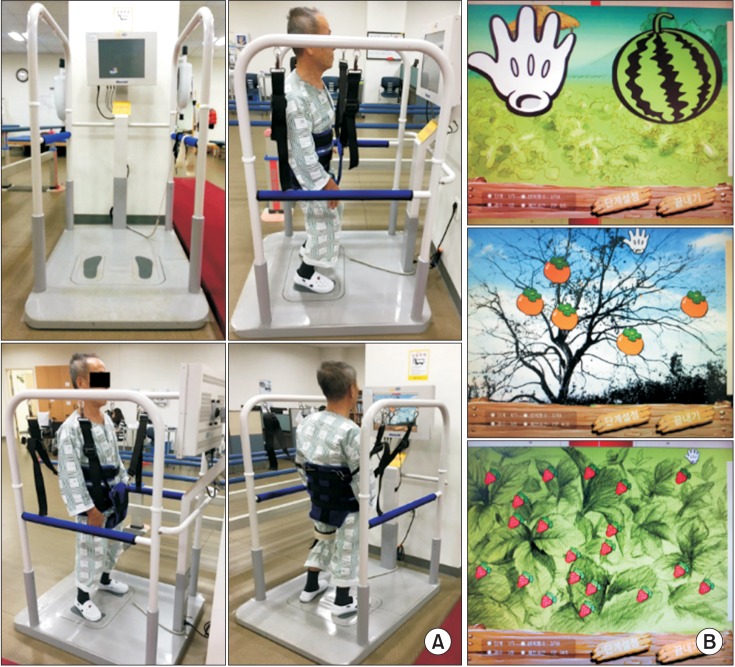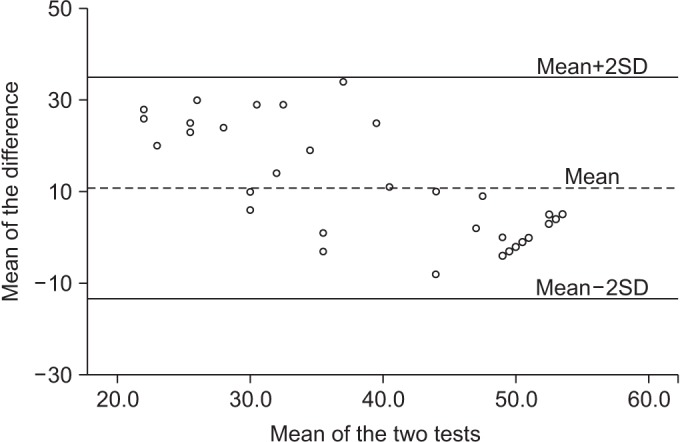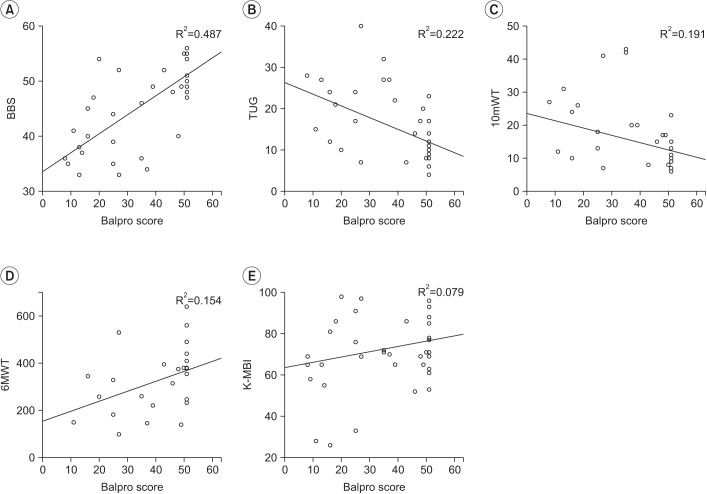Ann Rehabil Med.
2017 Apr;41(2):188-196. 10.5535/arm.2017.41.2.188.
Balance Assessment in Subacute Stroke Patients Using the Balance Control Trainer (BalPro)
- Affiliations
-
- 1Department of Rehabilitation Medicine, Daegu Fatima Hospital, Daegu, Korea.
- 2Department of Rehabilitation Medicine, Kyungpook National University College of Medicine, Daegu, Korea. teeed0522@hanmail.net
- 3Department of Rehabilitation Medicine, Kyungpook National University Medical Center, Daegu, Korea.
- KMID: 2389475
- DOI: http://doi.org/10.5535/arm.2017.41.2.188
Abstract
OBJECTIVE
To demonstrate the efficacy of the balance control trainer (BCT), developed for training patients with balance problems, as a balance assessment tool in subacute stroke patients.
METHODS
A prospective cross-sectional study was carried out on 38 subacute stroke patients in their first episode of a stroke, and having the ability to maintain a standing position without aid for at least 5 minutes. Patients were assessed using the BCT (BalPro) 43.7±35.7 days after stroke. The balance was assessed using the Berg Balance Scale (BBS), the Timed Up and Go Test (TUG), a 10-meter walking test (10mWT), a 6-minute walking test (6MWT), and the Korean version of the Modified Barthel Index. The correlation and validity between the BCT and various balance assessments were analyzed.
RESULTS
Statistically significant linear correlations were observed between the BCT score and the BBS (r=0.698, p<0.001). A moderate to excellent correlation was seen between the BCT score and 11 of the 14 BBS items. The BCT scores and other secondary outcome parameters (6MWT r=0.392, p=0.048; TUG r=-0.471, p=0.006; 10mWT r=-0.437, p=0.012) had a moderate correlation.
CONCLUSION
Balance control training using the BCT (BalPro) showed significant statistical correlation with the BBS, and could therefore be a useful additional balance assessment tool in subacute stroke patients.
Keyword
Figure
Reference
-
1. Gresham GE, Duncan PW, Stason WB, Adams HP, Adelman AM, Alexander DM, et al. Post-stroke rehabilitation. Rockville: US Department of Health and Human Services;Public Health Service;Agency for Health Care Policy and Research;1995.2. Tyson SF, Hanley M, Chillala J, Selley A, Tallis RC. Balance disability after stroke. Phys Ther. 2006; 86:30–38. PMID: 16386060.
Article3. Lamb SE, Ferrucci L, Volapto S, Fried LP, Guralnik JM. Risk factors for falling in home-dwelling older women with stroke: the Women's Health and Aging Study. Stroke. 2003; 34:494–501.4. Harris JE, Eng JJ, Marigold DS, Tokuno CD, Louis CL. Relationship of balance and mobility to fall incidence in people with chronic stroke. Phys Ther. 2005; 85:150–158. PMID: 15679466.
Article5. Belgen B, Beninato M, Sullivan PE, Narielwalla K. The association of balance capacity and falls self-efficacy with history of falling in community-dwelling people with chronic stroke. Arch Phys Med Rehabil. 2006; 87:554–561. PMID: 16571397.
Article6. Chen IC, Cheng PT, Hu AL, Liaw MY, Chen LR, Hong WH, et al. Balance evaluation in hemiplegic stroke patients. Chang Gung Med J. 2000; 23:339–347. PMID: 10958036.7. Bonan IV, Colle FM, Guichard JP, Vicaut E, Eisenfisz M, Tran Ba Huy P, et al. Reliance on visual information after stroke. Part I: balance on dynamic posturography. Arch Phys Med Rehabil. 2004; 85:268–273. PMID: 14966712.
Article8. Foley N, Peireira S, Cotoi A, Serrato J, Dukelow S, Sequeira K, et al. Mobility and the lower extremity [Internet]. London: Evidence-Based Review of Stroke Rehabilitation;2016. cited 2017 Mar 1. Available from: http://www.ebrsr.com/evidence-review/9-mobility-and-lower-extremity.9. Geurts AC, de Haart M, van Nes IJ, Duysens J. A review of standing balance recovery from stroke. Gait Posture. 2005; 22:267–281. PMID: 16214666.
Article10. Berg K, Wood-Dauphinee S, Williams JI. The Balance Scale: reliability assessment with elderly residents and patients with an acute stroke. Scand J Rehabil Med. 1995; 27:27–36. PMID: 7792547.11. Flansbjer UB, Holmback AM, Downham D, Patten C, Lexell J. Reliability of gait performance tests in men and women with hemiparesis after stroke. J Rehabil Med. 2005; 37:75–82. PMID: 15788341.12. Tyson SF, DeSouza LH. Development of the Brunel Balance Assessment: a new measure of balance disability post stroke. Clin Rehabil. 2004; 18:801–810. PMID: 15573837.
Article13. Howe JA, Inness EL, Venturini A, Williams JI, Verrier MC. The Community Balance and Mobility Scale: a balance measure for individuals with traumatic brain injury. Clin Rehabil. 2006; 20:885–895. PMID: 17008340.14. Benaim C, Perennou DA, Villy J, Rousseaux M, Pelissier JY. Validation of a standardized assessment of postural control in stroke patients: the Postural Assessment Scale for Stroke Patients (PASS). Stroke. 1999; 30:1862–1868. PMID: 10471437.15. Perera S, Mody SH, Woodman RC, Studenski SA. Meaningful change and responsiveness in common physical performance measures in older adults. J Am Geriatr Soc. 2006; 54:743–749. PMID: 16696738.
Article16. Eng JJ, Dawson AS, Chu KS. Submaximal exercise in persons with stroke: test-retest reliability and concurrent validity with maximal oxygen consumption. Arch Phys Med Rehabil. 2004; 85:113–118. PMID: 14970978.17. Barozzi S, Socci M, Soi D, Di Berardino F, Fabio G, Forti S, et al. Reliability of postural control measures in children and young adolescents. Eur Arch Otorhinolaryngol. 2014; 271:2069–2077. PMID: 24557440.
Article18. Furman JM. Posturography: uses and limitations. Baillieres Clin Neurol. 1994; 3:501–513. PMID: 7874405.19. Kohen-Raz R. Application of tetra-ataxiametric posturography in clinical and developmental diagnosis. Percept Mot Skills. 1991; 73:635–656. PMID: 1766798.
Article20. Sawacha Z, Carraro E, Contessa P, Guiotto A, Masiero S, Cobelli C. Relationship between clinical and instrumental balance assessments in chronic post-stroke hemiparesis subjects. J Neuroeng Rehabil. 2013; 10:95. PMID: 23941396.
Article21. Lee SH, Byun SD, Kim CH, Go JY, Nam HU, Huh JS, et al. Feasibility and effects of newly developed balance control trainer for mobility and balance in chronic stroke patients: a randomized controlled trial. Ann Rehabil Med. 2012; 36:521–529. PMID: 22977778.
Article22. Shumway-Cook A, Baldwin M, Polissar NL, Gruber W. Predicting the probability for falls in community-dwelling older adults. Phys Ther. 1997; 77:812–819. PMID: 9256869.
Article23. Wood-Dauphinee S, Berg K, Bravo G, Williams JI. The Balance Scale: responding clinically meaningful changes. Can J Rehabil. 1997; 10:35–50.24. Yelnik A, Bonan I. Clinical tools for assessing balance disorders. Neurophysiol Clin. 2008; 38:439–445. PMID: 19026963.
Article25. Wade DT. Measurement in neurological rehabilitation. Oxford: Oxford University Press;1992.
- Full Text Links
- Actions
-
Cited
- CITED
-
- Close
- Share
- Similar articles
-
- Effects of Balance Control Training on Functional Outcomes in Subacute Hemiparetic Stroke Patients
- The Effects of Additional Balance Training in Subacute Hemiplegic Stroke Patients
- Effects of the Balance Control Training in Chronic Hemiplegic Stroke Patients
- Effect of Mirror Therapy on the Balance, Gait and Motor Function in Patients with Subacute Stroke
- Assessment of Balance and Posture in Brain Disorders





